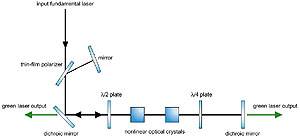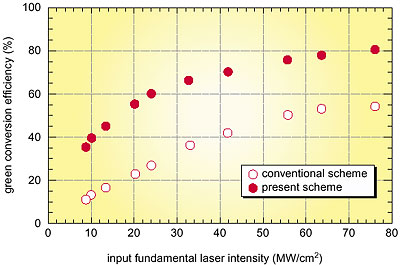The world's shortest-pulse 100 TW Ti:sapphire laser, which has been developed
at JAERI, is pumped by a green second-harmonic laser following frequency conversion of a 1064 nm fundamental Nd:YAG laser pulse, using such a crystal as KTiPO4. Frequency conversion efficiency is about 50%. To make a compact Ti:sapphire laser with high output power, the laser system must have a high energy-conversion efficiency in order to provide second-harmonic output while remaining within the permissible input power limit to avoid damage to the crystals.
We have proposed a new frequency scheme, arranging two nonlinear optical crystals in series with their optic axes orthogonal (four-pass quadrature arrangement). Thus, the second-harmonic output produced in the first crystal is not at the correct polarization for interaction in the second, and the input fundamental laser beam unconverted in the first can be reused for further frequency conversion in the second (Fig. 8-3). The process is repeated four times and finally, with the input fundamental laser (1064 nm, 607 mJ pulse, 10 Hz) having a power intensity of 76 MW/cm2, the generation of a 532 nm second-harmonic output laser pulse of 486 mJ has been achieved. This corresponds to an energy conversion efficiency of 80% (Fig. 8-4). |


